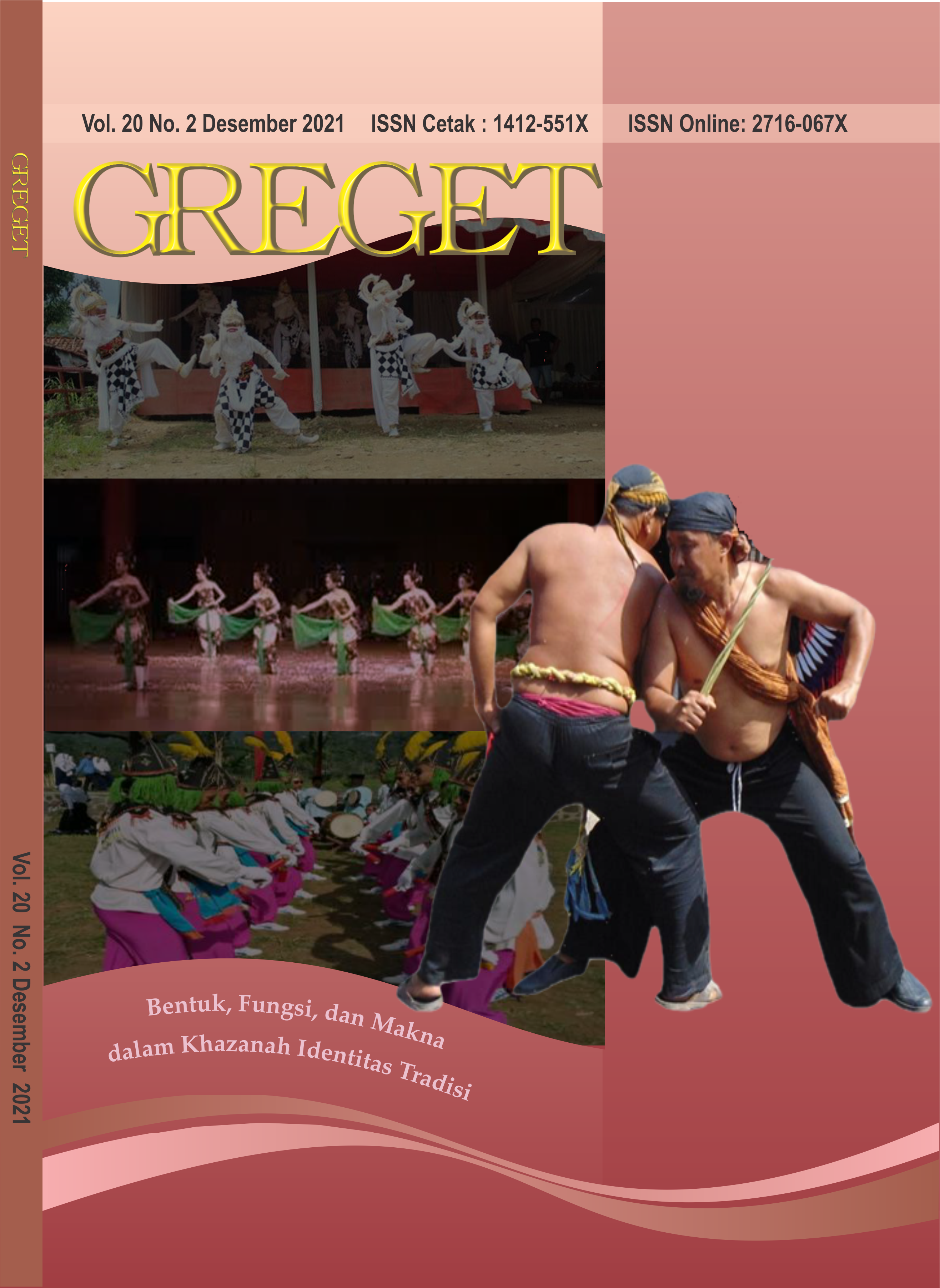IDENTITAS LOKAL SIDOARJO DALAM KOREOGRAFI BANJAR KEMUNING KARYA AGUSTINUS HERI SUGIANTO
Main Article Content
Abstract
Sidoarjo is known to have the city icon “Shrimp and Milkfish” because it has an area located on the coast and part of the livelihood of the community is fishermen. Coastal communities have distinctive cultural traits and characteristics with the habit of processing marine products. Sedekah Laut or Petik Laut is one of the cultures owned by the coastal community of Sidoarjo which is manifested in the form of the Banjar Kemuning dance. This study seeks to uncover problems related to local identity expressed in the choreography of the Banjar Kemuning dance. The research problems were analyzed based on the theory of culture and identity, the theory of choreographic concept analysis, the theory of art and identity and the theory of expression. This research is qualitative with data collected through literature study, interviews, and observations of Banjar Kemuning Dance. The results showed that the components of the Banjar Kemuning dance include: (1). Choreography, (2). Accompaniment music; poetry and narration, and (3). Clothing, (4).Properties that as a whole reflect the lives of coastal communities who are active, dynamic and do not forget to be grateful for the marine products they get from God Almighty in the form of a complete unity of the Banjar Kemuning dance.
Downloads
Article Details
Copyright
Authors who publish with GREGET agrees to the following terms:
- Authors retain copyright and grant the journal right of first publication with the work simultaneously licensed under a Creative Commons Attribution-ShareAlike 4.0 (CC BY-SA 4.0) that allows others to share the work with an acknowledgment of the work's authorship and initial publication in this journal.
- Authors are able to enter into separate, additional contractual arrangements for the non-exclusive distribution of the journal's published version of the work (e.g., post it to an institutional repository or publish it in a book), with an acknowledgment of its initial publication in this journal.
- Authors are permitted and encouraged to post their work online (e.g., in institutional repositories or on their website) prior to and during the submission process, as it can lead to productive exchanges, as well as earlier and greater citation of published work.
References
Langer, Suzanne K. 2006. Problematika Seni. FX Widaryanto. STSI Bandung: Sunan Ambu Press.
Magnis-Suseno, Franz. 1992. Filsafat Kebudayaan Politik. Butir-Butir Pemikiran Kritis. Jakarta: Gramedia.
Moleong, Lexy J. 2010. Metodologi Artikel Kualitatif. Bandung: Remaja Rosda Karya.
Mulyana, Dedy, Rahmat dan Jalaludin. 2006. Komunikasi Antar Budaya Paduan Berkomunikasi Dengan Orang-Orang Berbeda Budaya.Bandung:PT.Remaja Rosdakarya.
Murgiyanto, Sal, M.A. 1983. Koreografi Pengetahuan Dasar Komposisi Tari. Jakarta. Departemen Pendidikan dan Kebudayaan.
Narsidah. 2016. Tari Ronggeng Paser Sebagai Identitas Masyarakat Suku Paser di Kabupaten Paser Kalimantan Timur. Skripsi: Institut Seni Indonesia Yogyakarta.
Nugraha, Fatihah Pangastuti. 2019. Simbol Identitas Lokal Dalam Tari Banjar Kemuning. Skripsi: Sekolah Tinggi Kesenian Wilwatikta Surabaya
Prakosa, Rohmat Djoko. 2008. Mengintip Tubuh Penari. Surabaya. Tapel Press
Pramutomo, RM. 2021. Dance, Ceremonialism, and Politic In Indonesia. International Journal of Social Science And Human Research Volume 04 Issue 01 January 2021.
Prihatini, Nanik Sri, Sutarno Haryono dan R.M Pramutomo. 2012 . Kajian TariNusantara . Surakarta. ISI Pres.
Suwandari, Delfia Rachma. 2020. Tari Solah Ketingan Karya Agustinus Heri Sugianto (Kajian Kritik Pengudaran Teks Terhadap Koreografi Ketingan). Skripsi: Sekolah Tinggi Kesenian Wilwatikta Surabaya.
Sindara. 2013. Tari Kretek Sebagai Tari Identitas Budaya Kabupaten Kudus Jawa Tengah. Skripsi: Universitas Negeri Yogyakarta
S Hal, Ubid Abdillah.2002 . Politik Identitas Etnis: Pergulatan Tanda Tanpa Identitas. Magelang: Indonesiatera.
Soedarsono, R.M. 1998. Pertunjukan di Era Globalisasi.Direktorat Jenderal Pendidikan Tinggi Departemen Pendidikan dan Kebudayaan.
Spencer, Paul. 1985. Society And The Dancea: Teh Social Anthropology Of Process And Performance. Cambridbe University Press.
Sugiharto, Bambang dan Agus Rachmat. 2000 .Wajah Baru Etika & Agama. Yogyakarta. Yayasan Kanisius.
